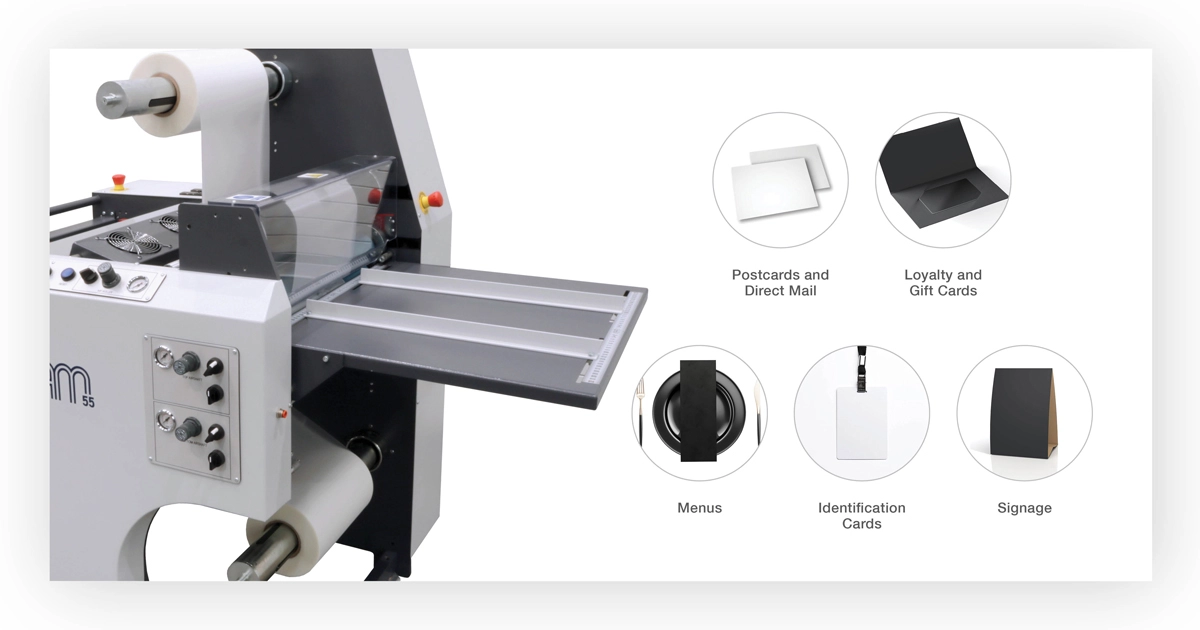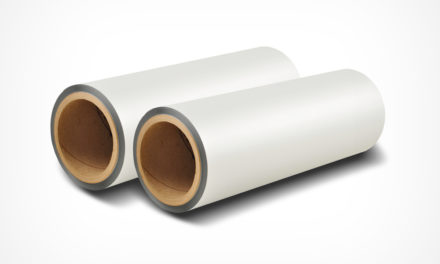WHAT IS DOUBLE-SIDED LAMINATION?
Double-sided lamination involves applying film to both the front and back of a printed sheet, making it thicker and giving it a protective barrier on each side. While single-sided lamination is a popular option in many general commercial printing applications, double-sided lamination is preferred in situations where durability, rigidity, and longevity are the primary goals.
In most commercial jobs, sheets that are laminated on both sides are cut so the laminate layers lie flush with the edges of the sheet, resulting in a product that offers more design flexibility with slightly lower protection against moisture, grease, and other contaminants. This form of double-sided lamination is most commonly seen on applications such as high-end menus, brochures, business cards, and direct mail. In these instances, a high level of protection is needed as the product will be used repeatedly, but the visual appeal is still of primary importance for marketing and branding purposes.
For settings where protection is of primary importance and longevity is needed, encapsulation is ideal. When a sheet is encapsulated, a clear laminate rim is left around the perimeter of the sheet when it is cut post-lamination, completely encasing the sheet. This type of lamination greatly reduces the risk of water damage, oil stains, and tearing and is an excellent option when the application will see repeated use, such as in restaurants, schools, or offices.
KNOWING YOUR APPLICATION
Before any other decisions are made, be it the material or equipment used, it is crucial to understand what qualities and performance levels the finished product will need. Consider factors such as what types of protection the piece will need, if it will be used repeatedly and how often it will be used, and whether it will have value-add effects or a specialty finish. Also, consider if the sheet will need to have flush-cut edges or be encapsulated.
Once you know exactly what will be required of the final product, you can narrow down which materials and equipment will be needed to turn a concept into a finished piece. Because the laminate material used has the greatest impact on what equipment will be needed and which value-add processes can be applied, this article will focus on how different materials function in double-sided lamination.
BOPP Laminates
Laminates made of biaxially oriented polypropylene (BOPP) are thinner and more malleable than their PET counterparts, making them excellent for brochures, business cards, and other applications that need a bit of flexibility. They come in a wide range of finishes and are compatible with most thermal laminating systems because they can be used with any separation mechanism, including burst separation. Many operators will perform double-sided lamination using BOPP laminates on a single-sided laminating system by first laminating one side and then performing a second run to laminate the other side. However, BOPP laminates are too flexible and soft to be used for encapsulation, which means they are suitable for flush-cut applications only.
Double-sided lamination with BOPP products is common in situations where embellishments and post-lamination processes are needed. This is because, compared to most PET laminates, the softness of BOPP materials makes them much more receptive to value-add processes, such as embossing, spot UV, and overprinting. Additionally, BOPP offers the widest range of specialty finishes and effects, from soft-touch and rough-touch options to scuff- and smudge-resistant properties.
BOPP laminates can also enhance the durability of sheets in an economical way because they are often less expensive than double-sided PET products. Operators may also decide to pair a specialty BOPP laminate with a gloss or matte backing to elevate the print in a cost-effective manner. Cellulose (CLS) can serve as a more environmentally conscious option for double-sided lamination applications that would otherwise use BOPP products. While CLS thermal laminates do include a plastic adhesive layer, their bio-based construction helps reduce overall plastic usage.
PET Laminates
Polyester (PET) laminates are highly durable and add rigidity to sheets, making them ideal for encapsulation and laminating both sides of trading cards, signage, menus, and other applications that need maximum durability because they are handled frequently throughout the day. PET is too durable for bursting separation, so a thermal laminating system with flying knife or hot knife separation is necessary to process these laminates. Flying rotary knife or guillotine separation may prove necessary for thicker double-sided applications.
PET laminates are available in the widest range of thicknesses, spanning from 0.8 mil to 10 mil in the Nobelus catalog. PET laminates that measure 3 mil thick or more are recommended for double-sided lamination only as laminating just one side of a sheet with a material this thick may result in curling. While some PET laminates offer specialty finishes, such as holographic and metallic effects, most thicker PET products are available only in gloss and matte versions.
Thickness is a crucial concern with PET laminates because the higher the ratio of base film to EVA adhesive, the more force the laminate tends to exert on the substrate. For this reason, it is critical that any PET laminates used in double-sided lamination apply roughly the same amount of tension to both the front and back of the laminated sheet. In thicker PET laminates of specialty construction, the risk of curling increases greatly if the laminates are not properly mapped and matched.
Mapping and matching is the process of pairing rolls of opposite tension to minimize the likelihood of curling in a finished piece. Regarding laminate construction, the heat-activated EVA adhesive layer commonly found on thermal laminates is soft and has less impact on curling than the film layer. A 5 mil PET laminate with a construction of 3/2 (3 mil adhesive and 2 mil PET) will create less tension than a 5 mil laminate that has a construction of 1/4 because the PET layer is thicker in the latter product. Mapping and matching helps ensure both sides of a laminated sheet exert the same amount of force to prevent curling.
Nylon Laminates
Nylon laminates are valued for their hygroscopic properties, which means they are able to lie flat despite changes in humidity and moisture levels in the surrounding environment. Nylon is recommended primarily to help laminated book covers lie flat against the book’s pages. Nobelus does not recommend that nylon be used in double-sided lamination due to the fact that its properties are highly specialized for use in book cover lamination.
WHAT EQUIPMENT IS BEST FOR DOUBLE-SIDED LAMINATION?
While there are thermal laminators designed specifically to perform double-sided lamination, most thermal laminators can be used to laminate both sides of a sheet in a pinch. Laminators specifically designed for double-sided lamination can laminate both sides in a single pass, but others must laminate each side of the sheet in a separate pass.
Double-sided laminators often require a greater financial investment than single-sided systems, so printers should carefully consider whether their operation will benefit from such equipment. To determine which thermal laminating system is best for your application, you will need to consider several factors, including volume, thickness, and material type. While it is difficult to provide a simple recommendation without a detailed look at a specific business, this article will sort laminators according to how much of an operation’s typical workload involves double-sided lamination.
Infrequent Double-Sided Lamination
Operations that perform double-sided lamination only sporadically may need only a standard single-sided laminator. This solution is viable only for especially low volumes or rare jobs because running each sheet through the laminator twice is a time-consuming process that extends turnaround times and keeps your machine from processing other jobs.
Bursting separation can be used for BOPP materials in this process because only one layer of film is separated at a time. As with any form of single-sided lamination, thicker materials or non-BOPP laminates may require a unit with hot knife or rotary knife separation.
A couple of our most popular single-sided laminating systems include the Komfi® Amiga 52 and the GMP® Protopic™ Auto-540 Dual Photo, which is ideal for digital photofinishing. Both of these units are capable of production volumes for single-sided applications and limited double-sided use.
Moderate Double-Sided Lamination
For operations that primarily perform single-sided lamination but still have a significant inflow of double-sided jobs, the Amiga 52 Double is undoubtedly the most suitable equipment option in the Nobelus catalog. This unit includes all the features of a standard Amiga 52 and can perform single-sided lamination, but it also includes a bottom film mandrel that can be engaged and disengaged as needed.
Because this laminator utilizes burst separation, it cannot process standard PET or nylon laminates over a certain thickness. For this reason, the Amiga 52 Double is suitable for double-sided lamination with BOPP materials only.
Printers who specialize in photofinishing may consider the Protopic Auto-540 Quatro or the PODMaster™ IDH 54 Quatro, both of which can perform in-line double-sided lamination and include an embossing roller that gives digital photos the luster of conventional silver halide photos. These units are excellent for printers who want to make their own photo paper in house as the back of the photos can be simultaneously laminated with a matte finish for added protection and aesthetic appeal.
Mostly Double-Sided Lamination
For the highest volume runs, operators will need a thermal laminator capable of performing in-line double-sided lamination with a variety of material types.
If the laminate film will sit flush with the edges of the sheet, the Amiga 52 Double remains an excellent option. Operators can easily keep the two-sided functionality activated the majority of the time and then disengage the lower laminate roll as needed for single-sided lamination. The Amiga 52 Double can withstand the highest volume jobs, but due to its bursting separation mechanism, it can reliably process only BOPP laminates and therefore is not suitable for PET projects or encapsulation.
For operators that need to process high volumes of encapsulated sheets, the StrataLam™ 55 Double-Sided Encapsulating Laminating System is a high-speed, high-efficiency laminating system capable of processing laminates ranging from 1.7 to 10 mil thick. Paired with the DuraFeed™ 52 Automatic Feeder and the DuraTrim™ 30 Automatic Trimmer/Sheeter, which uses flying knife separation, the StrataLam 55 laminator can perform encapsulation for a wide range of applications. This specialty unit cannot perform single-sided lamination and is therefore only recommended for operations that have enough double-sided lamination volume to justify a devoted machine.
NEED MORE INFORMATION?
If you’d like to learn more about double-sided lamination, don’t hesitate to reach out to our team through our Contact Us page. Our solutions experts can help you determine which products and laminating systems would be best for your unique needs. For those new to double-sided lamination, our in-house service team can help you test different materials and equipment to validate which options will work for your application. If you experience issues in your facility, our technicians are available to help you troubleshoot any issues in person or through virtual or phone support.





